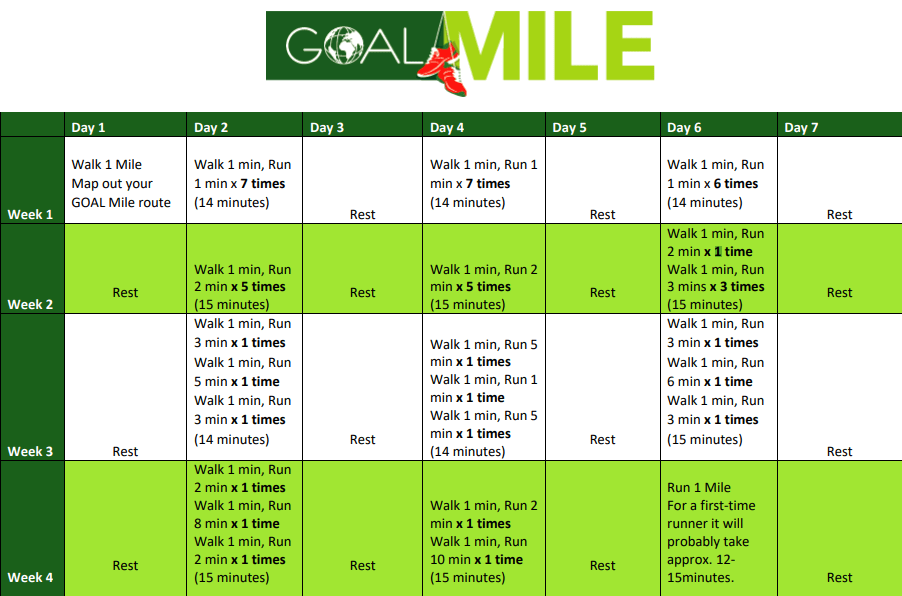 Blogs
Blogs
November 26, 2023 • 4 min read
Our friends at the Coast Road Runners have put together their top 12 tips for aspiring runners ahead of the GOAL Mile
"Believe in yourself. If you want to run you can run. Running is all about mind over matter. Your legs will do what your mind tells it to. So tell yourself that you can run a mile and you will run a mile. And enjoy the post runners high that you have heard about from so many runners!"
1. Wear Good Runners
Wear runners designed for running vs fashion type runners. Check the soles of your runners. If worn down, and you can afford it invest new runners because the soles give your joints and muscles the support needed for running.
2. Stretch
Stretch before and after each run, stretching all the key running muscle groups. This is key to staying injury free. Hold each stretch for 10-12 seconds. You need to feel the relative muscle being stretched. If you don’t, stretch deeper. See Coast Road Runners 9 pre and post run stretches. Do 2 sets of them before and after each run.
3. Hydrate
Hydrate before and after running. If you drink enough water before you run, it will keep you hydrated during your run so you won’t need to drink while running.
4. Keep a Steady Pace
Don’t run too fast, especially at the start. When running, you shouldn’t be huffing and puffing out of breath. If you are, slow down until your breathing regulates. As your fitness improves, so too will your ease of breathing. So don’t worry if your breathing is a bit laboured at first.
5. Stand Tall and Breathe
Run upright vs having your shoulders slouched/bent. This gives you a fuller amount of oxygen into your lungs when you breathe. Breathe in and out through your mouth vs your nose if possible. You get a fuller amount of oxygen this way especially if your nose is blocked.
6. Foot Strike
Try to avoid running flat footed i.e. Where your whole foot (front and back) lands on the ground at the same time. You can hear your footsteps when this happens. Ideally try to land on the front, mid or back of your foot first.
7. Running Route
Choose as continuous a path as possible with the least amounts of roads to cross. Be careful of dips in the paths outside driveways etc. And running on/off kerbs. If running on grass, be careful of uneven/bumpy areas so that you don’t trip/twist your ankle. If running on grass, ideally run on a worn track where possible.
8. Wear Breathable Running Clothes
When running, you’re body automatically heats up so you don’t need heavy clothing. Even in the depths of winter, it is better to wear layers of light breathable clothing rather than heavy clothing. As you heat up, you can remove your outer layer and wrap it around your waist.
9. Run Lightly
Carry as little as possible when running. You should only need a key (or medication is required). Take your house/car key off your keyring so you aren’t weighed down with a big set of keys. If you need your phone, use an arm band. You only need to carry water for long distance running.
10. Run, Rest, Repeat
Ideally run 2-3 times per week, and always leave at least a day in between each run. These rest days are key to preventing injury and straining your body.
11. Run All Year Round
One of the best things about running is that it doesn’t matter what the weather is like outside. You can run in the wind and rain, when it’s hot or cold, day and night. The only time that it is advisable not to run, is when it is unsafe to do so e.g. Ice on the ground or during a high level storm.
12. Listen to Your Body
It is very common to feel niggles etc. when running. But if something feels like more than a niggle and is sharp/persistent, get checked out. If a minor injury goes untreated for too long, it can take longer to recover from.
The 4 Week GOAL Mile Training Plan
Follow Coast Road Runner’s tailored 4 week training plan to run your first virtual GOAL mile this December. It involves 3 running sessions per week.
Each session is approx. 15 minutes long. Track the minute intervals on your watch or download a free app such as the HIIT Interval Timer. Track your distance on your watch too or download a free app such as MapMyRun.
Most first time runners will run 1 mile in approx. 12-15 minutes. Some will be shorter. Some longer. It doesn’t matter how long or short it takes you. Running it is all that counts. Before you start the training plan, read our training tips. So you get off on the right foot!

